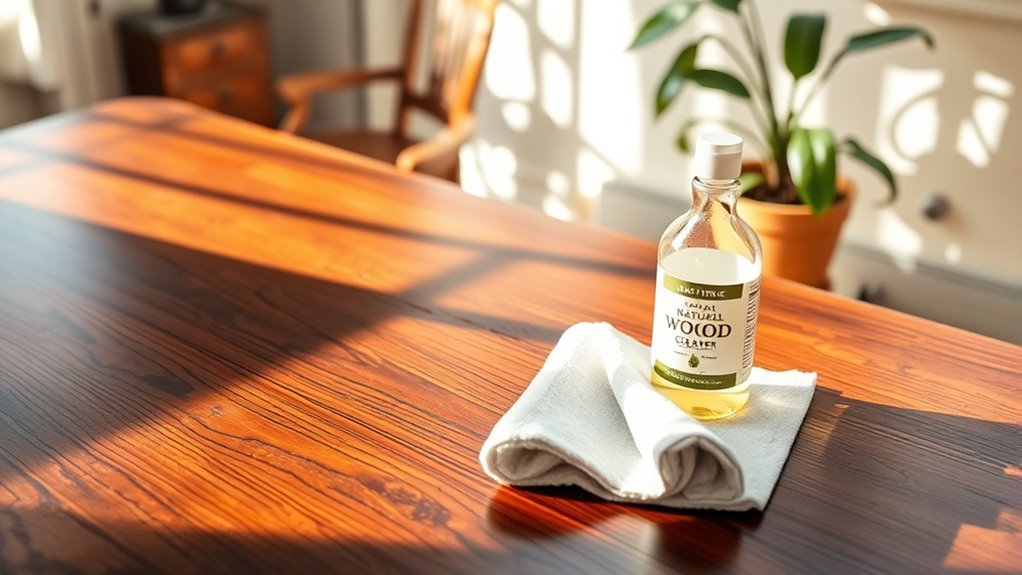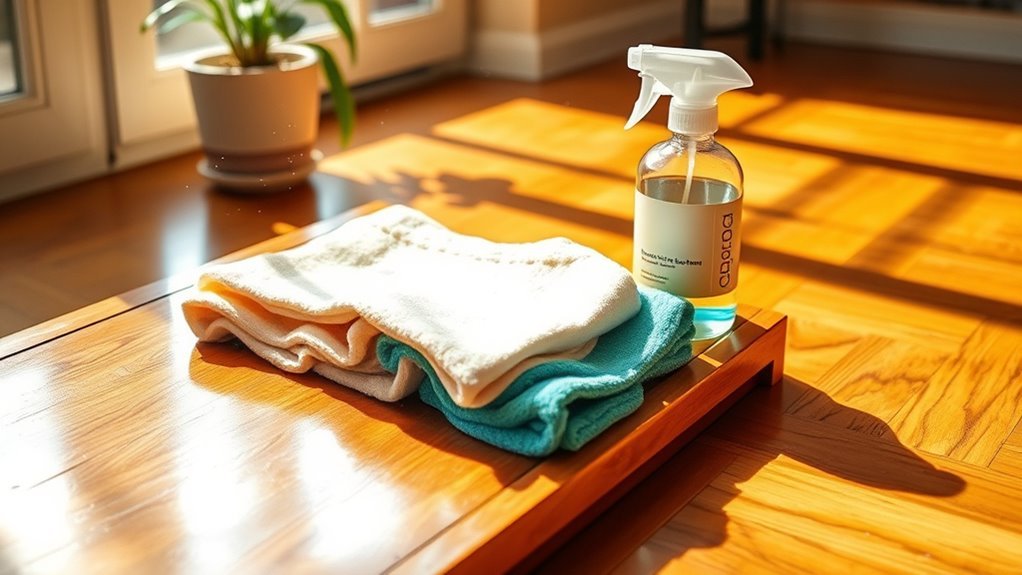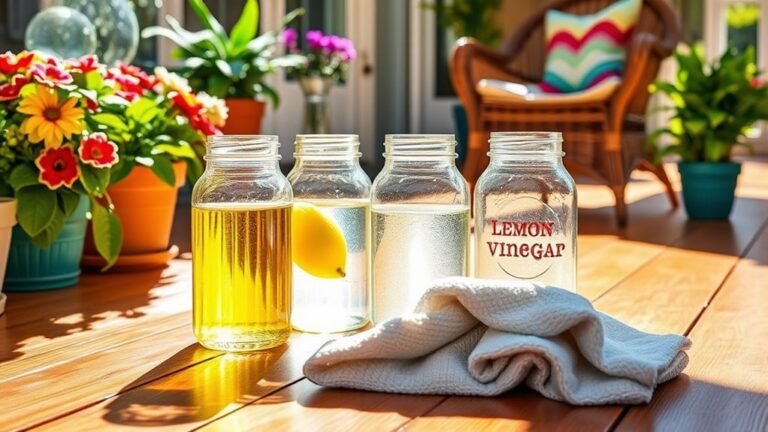Weekly Cleaning Routine for Wood
To keep your wood looking great each week, start by gently dusting with a soft cloth or microfiber to avoid scratches. Use a mild soap and water mix for cleaning, wiping along the grain without soaking the surface. Dry thoroughly with a soft towel, and consider applying polish to protect the finish. Avoid harsh chemicals and excess moisture to prevent damage. If you want to preserve your wood’s charm and durability longer, there are a few more useful care tips to explore.
Understanding Different Types of Wood Finishes

Before you begin cleaning, it’s important to understand the type of finish on your wood surfaces. Knowing whether your wood has oil finishes or lacquer finishes can change how you approach your weekly routine. Oil finishes penetrate the wood, enhancing its natural beauty while providing a protective layer. They’re more forgiving and allow you to use mild cleaners without stripping away the finish. Lacquer finishes, on the other hand, create a hard, glossy surface that’s more vulnerable to harsh chemicals and scratches. When you know your finish, you’re free to choose methods that protect and preserve your wood’s character. This understanding helps you maintain its beauty without limiting your cleaning options or risking damage, giving you the freedom to enjoy your wood surfaces for years to come.
Gathering the Right Cleaning Supplies
To keep your wood surfaces looking their best, you’ll need the right cleaning tools and safe products designed specifically for wood. Choosing gentle, non-abrasive cleaners helps protect the finish, while having soft cloths and brushes makes cleaning easier. Don’t forget to store your supplies properly to keep them ready for your weekly routine.
Essential Cleaning Tools
Although wood surfaces are durable, they require specific tools to keep them looking their best. To maintain that natural beauty without restricting your time or energy, start with quality cleaning cloths—they’re gentle yet effective for wiping dust and spills. Microfiber cloths work great because they trap dirt without scratching. Next, grab scrub brushes with soft bristles for those tougher spots or grooves where dirt hides. Avoid anything too harsh that might damage the wood. Having these tools on hand lets you clean efficiently and freely, without fuss. When you invest in the right cleaning cloths and scrub brushes, you’re setting yourself up for a simple, effective routine that keeps your wood surfaces fresh and inviting week after week.
Safe Wood-Friendly Products
Since wood is sensitive to harsh chemicals, you’ll want to choose cleaning products specifically designed for wood surfaces. Opting for eco friendly cleaners not only protects your wood but also aligns with a lifestyle that values freedom from toxins. Natural alternatives like diluted vinegar solutions or mild castile soap are excellent choices—they clean effectively without damaging the finish. Avoid ammonia-based or abrasive products that can strip wood’s natural oils. When selecting your supplies, look for labels that highlight safe ingredients and biodegradability. This way, you’re caring for your wood and the environment simultaneously. By gathering the right, gentle products, you guarantee your wood remains vibrant and strong, giving you the freedom to enjoy its beauty without worry every week.
Storage Tips for Supplies
Keeping your cleaning supplies organized in one easily accessible spot makes your weekly routine much smoother. With thoughtful supply organization, you free yourself from hunting down items and gain more time for what matters. Consider these storage tips:
- Use clear storage containers to easily identify contents without opening them.
- Label each container for quick access and to maintain order.
- Store frequently used items at eye level or within arm’s reach to save effort.
- Allocate separate containers for different product types to prevent spills and mix-ups.
Dusting Techniques for Wood Surfaces
Anyone who cares for wood surfaces knows that dusting is an essential step in maintaining their beauty and longevity. When you dust, choose soft dusting cloths that won’t scratch or dull the wood’s finish. Microfiber cloths work wonders—they trap dust instead of just pushing it around. Pair these with quality dusting tools like extendable dusters or brushes with gentle bristles to reach tricky corners and grooves. Make dusting a light, regular habit—this keeps dust from building up and damaging the wood over time. Remember, freedom with your routine means adjusting tools and timing to what suits your space best. By mastering these dusting techniques, you protect your wood surfaces effortlessly while enjoying the freedom of a clean, fresh home.
Preparing a Gentle Cleaning Solution

To keep your wood surfaces looking their best, you’ll want to choose ingredients that are safe and gentle. Mixing the right proportions guarantees your cleaning solution won’t damage the finish or leave residue. Let’s look at how to prepare a solution that cleans effectively without harming your wood.
Choosing Safe Ingredients
Why should you be careful about the ingredients you use when cleaning wood? Because wood is sensitive, harsh chemicals can damage its finish or cause discoloration. To maintain your freedom to enjoy beautiful, lasting wood surfaces, prioritize ingredient safety by choosing natural cleaners. Here’s what to evaluate:
- Opt for plant-based ingredients that are gentle yet effective.
- Avoid ammonia, bleach, and other strong solvents that strip wood’s natural oils.
- Check labels for additives that might harm finishes or irritate your skin.
- Select solutions free from synthetic fragrances and dyes to reduce chemical exposure.
Mixing Proper Ratios
Three key measurements will help you mix a gentle cleaning solution that’s safe for your wood surfaces. Start by combining one tablespoon of mild dish soap with one cup of warm water. This ratio guarantees your cleaning solutions are strong enough to lift dirt but gentle enough to protect the wood’s finish. Next, add a quarter cup of white vinegar to the mix for natural disinfecting power without harsh chemicals. Avoid overdoing it—too much vinegar can damage wood. Finally, always test your solution on a small, hidden area before applying it broadly. By mastering these mixing ratios, you maintain your wood’s beauty and durability while enjoying the freedom of using simple, effective cleaning solutions you create yourself.
Proper Methods for Mopping Wood Floors
Although mopping wood floors might seem straightforward, using the wrong technique can damage the surface over time. To keep your floors looking great without restricting your freedom, follow these mopping techniques with the right cleaning frequency:
- Use a damp mop—never soak your wood floors; excess water causes warping.
- Choose a cleaner specifically designed for wood floors to maintain the finish.
- Mop in the direction of the wood grain to avoid streaks and buildup.
- Stick to a weekly cleaning frequency, adjusting if your space sees heavy traffic.
Cleaning Wood Furniture Without Damaging It

Keeping your wood floors clean is important, but the wood furniture in your home also needs careful attention to avoid damage. When cleaning wood furniture, stick to gentle cleaning techniques like using a soft cloth dampened with water or a mild wood cleaner. Avoid harsh chemicals or excessive water, which can cause warping or discoloration. Regular dusting prevents buildup that scratches the surface. For maintenance tips, always wipe spills immediately to protect the finish and use coasters or pads to avoid dents and stains. By incorporating these simple cleaning techniques into your weekly routine, you’ll preserve the natural beauty of your wood furniture without risking damage. This approach lets you enjoy your space freely, keeping your wood pieces looking fresh and durable over time.
Tips for Drying and Polishing Wood
Once you’ve cleaned your wood surfaces, it’s important to dry them properly to prevent moisture damage. Using the right drying techniques guarantees your wood stays vibrant and strong.
Here’s how you can master drying and polishing wood:
- Use a soft, lint-free cloth to gently blot away moisture—never rub aggressively.
- Allow air circulation by opening windows or using a fan to speed up drying.
- Choose natural polishing methods like beeswax or plant-based oils to nourish without harsh chemicals.
- Apply polish sparingly with a microfiber cloth, following the wood grain for a smooth, effortless shine.
Preventive Measures to Protect Wood Between Cleanings
To maintain your wood’s beauty and durability, you’ll want to take some simple preventive steps between cleanings. Focus on wood protection by minimizing exposure to moisture, direct sunlight, and extreme temperatures, all of which can cause warping or fading. Use coasters and placemats to prevent stains and scratches, giving your wood freedom to stay flawless longer. Regularly dust with a soft cloth to avoid buildup that can wear down surfaces. Preventive maintenance also means inspecting your wood for any signs of damage early, so you can address issues before they worsen. By integrating these small habits into your routine, you’re not just preserving your wood—you’re enjoying the freedom of knowing it’s protected without constant worry or heavy upkeep.
Häufig gestellte Fragen
Can Wood Surfaces Be Cleaned With Vinegar?
You can clean wood surfaces with vinegar, but you’ve got to be careful. Vinegar benefits include its natural disinfecting power, which helps keep things fresh without harsh chemicals. However, because vinegar is acidic, it might damage the wood’s finish or harm its preservation if used too often or undiluted. To keep your wood safe and looking great, dilute vinegar with water and test it on a small spot first.
How Often Should Wood Furniture Be Refinished?
You’ll want to contemplate the refinishing frequency based on how much wear your wood furniture gets and how long you want it to last. Typically, refinishing every 7-10 years helps extend the furniture lifespan, keeping it looking fresh and protected. If your pieces see heavy use or start showing scratches, you might refinish more often. Trust your instincts—refinishing lets you refresh your space and enjoy your wood’s natural beauty for years to come.
Is It Safe to Use Steam Cleaners on Wood Floors?
You want your wood floors spotless, and steam cleaner effectiveness sounds tempting, right? But here’s the catch: steam can be both a friend and a foe. While it cuts through grime quickly, the moisture and heat risk warping or damaging your wood. For wood floor maintenance, it’s safer to avoid steam cleaners or use them sparingly with caution. Freedom in cleaning means choosing methods that protect your floors long-term.
What Temperature Should Water Be for Cleaning Wood?
When you’re cleaning wood, you’ll want to keep the water temperature moderate—lukewarm is best. Using hot water can damage the finish and wood fibers, so stick to a gentle cleaning temperature to protect your wood’s natural beauty. This way, you maintain proper wood care without limiting your freedom to refresh your space. Remember, a little care goes a long way in keeping your wood surfaces looking great and lasting longer.
Can Essential Oils Damage Wood Finishes?
You might wonder if essential oils can damage wood finishes. While essential oils bring a natural scent and some cleaning power, they can sometimes harm certain wood finishes, especially if they’re undiluted or used too often. To protect your freedom to enjoy your wood furniture, test oils on a small, hidden spot first. If you want to keep your wood looking great, always dilute essential oils and avoid harsh, abrasive applications.






